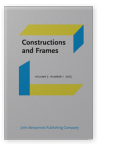Vol. 5:1 (2013) ► pp.88–116
A comparison between Fluid Construction Grammar and Sign-Based Construction Grammar
Construction Grammar has reached a stage of maturity where many researchers are looking for an explicit formal grounding of their work. Recently, there have been exciting developments to cater for this demand, most notably in Sign-Based Construction Grammar (SBCG) and Fluid Construction Grammar (FCG). Unfortunately, like playing a music instrument, the formalisms used by SBCG and FCG take time and effort to master, and linguists who are unfamiliar with them may not always appreciate the far-reaching theoretical consequences of adopting this or that approach. This paper undresses SBCG and FCG to their bare essentials, and offers a linguist-friendly comparison that looks at how both approaches define constructions, linguistic knowledge and language processing.
Cited by (12)
Cited by 12 other publications
This list is based on CrossRef data as of 1 july 2024. Please note that it may not be complete. Sources presented here have been supplied by the respective publishers. Any errors therein should be reported to them.
